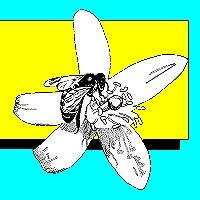APIS Volume 8, Number 12, December 1990

In this issue
- Taking Stock in 1990--Yearly Summary
- The Budget APIS and the Entomology Department
- Oils as Insecticides
- Arizona Highways Bee Article
TAKING STOCK IN 1990
This will be the 95th consecutive number of APIS to be published since Hum of the Hive got a face lift in February, 1983. Every year at this time, I try to take stock of what has happened in the last twelve months and provide a glimpse into the future.
As expected, 1990 was the year of the African bee. In January and February,APIS carried articles on planning for the bee's arrival in Florida and results of the DNA honey bee research program underway at the University of Florida. A new video, A Glimpse of Florida Beekeeping, was also released which is a good resource to use in communicating to the general public what Florida beekeeping is all about. And, of course, there followed the news that the bee was finally detected in Texas (October). Trapping bees and expanded knowledge about the bee's potential northern distribution were covered in the November issue.
Varroa bee mites also received a lot of ink. The June issue summarized thoughts on stock introduction to combat the mite. There continue to be many persons who don't know about Varroa, still very new to beekeepers in the U.S.; the August APIS provided a quiz to ensure readers were up to date on this parasite. This was closely followed by a description of the first find of fluvalinate, the only material approved to control Varroa, in honey. As a followup, the September issue (which also noted that particular month as National Honey Month) detailed a resume of food safety concerns along with information on honey contamination crisis programs.
Bee management was also featured with articles on limiting factors (April), the "sad and bad" bee phenomenon reported in California and reflections on protein management (July), and oiling your bees for tracheal mite control (May. A sprinkling of other issues were also reported: infotainment--the media's hybrid of information and entertainment (March), professionalism in the beekeeping business (May), and registration requirements (July).
THE BUDGET APIS AND ENTOMOLOGY DEPARTMENT
The 1990-1991 fiscal year continues to be more critical than most due to extreme budget cuts at the state and federal levels which are affecting Cooperative Extension programs at all levels. As a postscript to my call for support in the October issue of APIS, I wish to thank all those who took the time to write about the service this newsletter provides to beekeepers everywhere. It was gratifying, but the fight is probably not yet over.
I have always tried to find a succinct description of the kind of publication APIS really is. It is not meant to and cannot compete with the established big three beekeeping subscription publications in the U.S. It was Kim Flottum, editor of Gleanings in Bee Culture, who put his finger on it. "APIS seeks to write "around the edges of beekeeping." This is more than food for thought; it provides one reasonable answer to the question: why publish one more bee newsletter?
We have now completed our move into the new building in Gainesville. Notice the changed address and added extension number on the telephone. Although physically moved, this is really only the beginning. You can expect to see significant changes in departmental programs, including that devoted to apiculture, as we adjust to the new location.
It is certain that Varroa mites, African bees and food safety will still be of great concern to the beekeeping industry in 1991. Although there are plenty of problems surrounding these issues, at least beekeepers can now focus more easily than in the past when they were only on the horizon. And it is important to remember that all of them are manageable in one way or another. It is the decade of the manager, as many pundits have said. And often, the manager's point of view determines the probability of success or failure of a venture. As I said last year at this time while trying to sum up what we might expect in the 1990s, "It will depend on whether those involved (managers and beekeepers) perceive their cup as half empty or half full."
OILS AS INSECTICIDES
The use of various kinds of oils as insecticides is receiving a good deal of attention these days. They have a number of advantages, being in the main biodegradable, and will not adversely affect the environment many insecticides. An article in the IPM Practitioner, Vol. XII, No. 8, August, 1990, describes a basic stock solution used to kills aphids, whiteflies and spider mites on cotton and vegetable plants. It is one to 2 1/2 teaspoons of a mixture of one tablespoon (15 ml) dishwashing detergent and one cup (237 ml) vegetable oil to a cup of water. A fine spray of this solution is applied to leaves of plants. In summary, the authors say: "...household cooking oils and liquid detergents, available in most homes, provide a safe and economical solution for control of several common insect and mite pests that plague the home gardener. Phytotoxicity may occur on certain plant types such as squash and crucifers."
This information may be valuable for beekeepers to communicate to home gardeners. In addition, this solution may also be a good candidate for eliminating unwanted bee swarms. A paper at the latest American Bee Research Conference compared killing swarms by using several materials. Water and detergent mixed sixteen to one worked well; however, use of detergent has been criticized as polluting the environment. In many communities there are strict regulations concerning the disposal of "gray" or soapy water. By mixing in vegetable oil, the amount of detergent used can be reduced. It should be emphasized that although this technology is promising, it is technically not legal to use either detergents or vegetable oils as insecticides.
The reason for the above paradox is that both materials are not registered with the Environmental Protection Agency (EPA) for this use. Thus, it is illegal even to recommend the use of these materials. This is a classic "catch 22" that must somehow be resolved as registration of these materials is highly unlikely. It takes at least $150,000 for filing fees and much more money to run the appropriate tests required by EPA. There is little incentive to spend this amount on a relatively inexpensive product just to register its use as an insecticide.
ARIZONA'S SWEET BEES
The March issue of Arizona Highways has a piece on the honey bee, entitled, "Arizona's Sweet Bees." The striking part of the this article is the profuse use of color pictures. Bees are shown inspecting foundation, probing flowers and chewing their way out of the comb as they achieve adulthood. The information is also refreshingly different than in most articles of this nature I've seen. For example, the Goulds at Princeton are quoted as saying that the honey bee is as advanced an organism as the human on its side of the animal family tree which includes 17 phyla, the arthropods (and insects) being dominant. On the other side, where humans are at the top, 4 phyla are represented. One cannot but wince a little at at the hubris in the statement attributed to the Goulds, however, "...whereas humans are the most highly evolved species on our branch. To look at honey bees, then is to see one of the two most elegant solutions to the challenges of life on this planet."
Steve Buchman at the Carl Hayden Bee Research Laboratory also is quoted as describing honey bees' bodies as "living Swiss Army knives." This image brings to mind the quaint Christmas flick now at many theaters, Edward Scissorhands. Maybe bees and humans aren't all that far apart.
With reference to the African bee, the article beats the refrain we have heard for many years, predicting a decline in beekeeping (especially) hobbyists in the sunbelt where many municipalities are likely to introduce stringent laws concerning keeping these insects. In time, however, beekeepers will learn to manage them. As the article concludes: "For as long as we have records, people have lived with bees. There is no reason to believe the honeymoon will end soon." This is a well-written article that many will be able to use as a reference for those calls by journalists asking one to "tell me all you know about honey bees and beekeeping in the next 90 seconds."
Malcolm T. Sanford
Bldg 970, Box 110620
University of Florida
Gainesville, FL 32611-0620
Phone (904) 392-1801, Ext. 143 FAX: 904-392-0190
http://www.ifas.ufl.edu/~entweb/apis/apis.htm
INTERNET Address: MTS@GNV.IFAS.UFL.EDU
©1990 M.T. Sanford "All Rights Reserved














